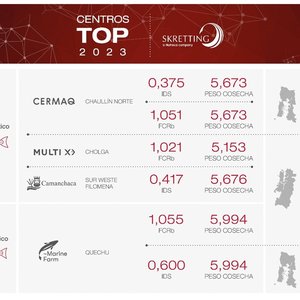NOAA’s effort to increase domestic seafood production through aquaculture gained tremendous momentum recently, when President George W. Bush emphasized the need for sustainable aquaculture in the United States, and urged Congress to move ahead on the National Offshore Aquaculture Act (S. 1195).
In his June 15 remarks at the White House announcing the designation of the Northwest Hawaiian Islands as a National Monument, the president said, “Congress needs to move forward with my administration's plan to build a well-managed system of offshore aquaculture … And when we get this right, these farmed fish can provide a healthy source of food and reduce pressure on the ocean ecosystems.”
offshore bill, which calls for the creation of a regulatory framework for aquaculture in federal waters. NOAA believes that carefully sited, regulated and monitored finfish and shellfish operations in U.S. federal waters can be an effective way to reduce our nation’s growing dependence on seafood imports, provide jobs for economically depressed coastal communities and increase regional food supply and security. Enactment of the administration’s bill would give NOAA the authority to begin a public rulemaking process to produce a comprehensive, environmentally sound permitting and regulatory program for aquaculture in federal waters. Regulatory uncertainty is widely acknowledged as the major barrier to the development of offshore aquaculture in the United States.
What distinguishes offshore aquaculture from other forms of aquaculture is the location in open ocean waters exposed to wind and waves. Specifically, “offshore” refers to the federally managed area of the ocean off the coasts of the United States and its territories. The “offshore” or federal waters begin where state jurisdiction ends, usually three nautical miles offshore in most coastal states, and extends all the way out to the outer limit of the U.S. Exclusive Economic Zone, 200 nautical miles offshore.
NOAA Testifies at Congressional Hearings
Transmitted to Congress in June 2005, the bill has been the focus of vigorous debate on a national level, including two Senate hearings. The hearings, another important step forward for the bill, allowed lawmakers to focus on various aspects of U.S. aquaculture, including aquaculture’s important role as a complement to our nation’s wild fisheries and as a source of seafood to help the rising consumer demand. For example, the United States imports over 70 percent of its seafood, or four million tons annually, to meet current demand. About half of those imports are from aquaculture.
NOAA’s Deputy Undersecretary for Oceans and Atmosphere, Timothy R.E. Keeney, testified on the bill on June 8, before the Senate Commerce Committee's National Ocean Policy Study Subcommittee. That hearing, which included four other witnesses, focused broadly on the potential benefits and challenges of opening up federal waters to aquaculture. At the initial subcommittee hearing on April 6, NOAA’s Assistant Administrator for Fisheries, William T. Hogarth also testified on the bill. At that hearing, the committee also heard testimony on current offshore aquaculture research, the U.S. aquaculture industry and the impacts that expanded aquaculture operations could have on fishermen, seafood processors and consumers.
The strongest message from NOAA to the subcommittee at both hearings was the need for balance as it considers a new regulatory framework. Hogarth drove home this message on April 6 when he said, “The bill will provide regulatory certainty, which is important to the offshore aquaculture industry, as well as to those who are concerned about the potential impacts of offshore aquaculture. Business needs regulatory certainty in order to make sound investment decisions and obtain financing. Those concerned about the impacts of offshore aquaculture need to know that the industry will be held to strict environmental standards.”
Hogarth also emphasized that NOAA supports the development of a domestic marine aquaculture industry in the United States to meet the growing demand for seafood and is committed to working with its stakeholders to ensure that it happens in a predictable, environmentally compatible and sustainable manner. “We also want to ensure that the protection of the marine environment, the rights of other users of marine resources, and human health and safety are a top priority,” he said.
The reality of today’s global seafood market is that seafood demand exceeds the supply from wild fisheries, and U.S. consumers are already consuming seafood from aquaculture — much of it imported. Those imports also add up to an eight billion dollar annual seafood trade deficit in the United States.
In terms of global numbers, the United Nations Food and Agriculture Organization estimates that in 2002, 35.2 percent of the world’s 145.9 million tons of fisheries landings came from aquaculture. Worldwide, aquaculture has grown an average of nine percent per year since 1970, compared with a 1.2 percent growth of capture fisheries.
Factors including health benefits, taste and affordability are all driving the increased demand for seafood. Americans currently consume 16.6 pounds of seafood per year. That is up from 16.3 pounds per person in 2004. In recognizing that a diet rich in seafood is a healthy diet, nutritionists are encouraging Americans to double our consumption of seafood to two seafood meals per week, up from one.
In the United States, freshwater aquaculture production, such as catfish, trout and tilapia, far outpaces marine aquaculture, which is dominated by shellfish culture. Right now, U.S. aquaculture operations — freshwater and marine — are either coastal or land-based. There is no aquaculture in federal waters. However, there are several projects operating in open ocean conditions in state waters that are demonstrating that with the proper siting, equipment and monitoring — safe, sustainable offshore aquaculture is possible.
Aquaculture in the United States
In the future, the United States will need all forms of aquaculture — freshwater and saltwater, finfish and shellfish, existing and new technologies — to meet growing demand for seafood. NOAA’s current program is working to address and support all forms of marine aquaculture, including coastal shellfish, algae and finfish culture, marine stock enhancement (hatcheries) for species important to commercial and recreational fishing, and the culture of pharmaceutical and other by-products from aquaculture.
Based on the current level of U.S. aquaculture production, the real challenge is to integrate aquaculture into domestic seafood production so that boat owners, fishermen and processors can benefit directly from aquaculture. In some cases, U.S. fishermen have already integrated with or linked to aquaculture as part of their overall operation. For example, fishermen in New England who are interested in adding aquaculture as part of their business and researchers at the University of New Hampshire are working in tandem to design equipment, site operations and share knowledge while operating cod and mussel farms in open ocean locations. On the opposite end of the East Coast, fishermen in Florida, displaced by closures of wild fisheries or declining catches, have successfully turned to shellfish aquaculture.
Right now, states along the Gulf of Mexico are looking to aquaculture to help rebuild seafood infrastructure and retain seafood jobs. Fishing communities damaged by the hurricanes are seeking to rebuild docks, processing and distribution facilities. Aquaculture could provide additional fish and shellfish to local processing plants, and fishermen may be able to use existing vessels to support aquaculture operations.
Why Go Offshore?
As competition for space and the loss of nearshore and coastal areas with suitable water quality for aquaculture operations increases, so does the interest in the offshore. Less competition for space and the natural characteristics of offshore waters — deeper water, stronger current flow and superior water quality — add up to make the offshore an appealing option for those operators willing to forge the way for this emerging form of aquaculture.
Right now in the United States there are four open ocean aquaculture operations growing finfish, two operations in Hawaii, one in Puerto Rico and one in New Hampshire. All four operations grow species native to their area. All four use similar technology in their operations, including a set of submerged cages moored to the ocean bottom. In addition to finfish, the New Hampshire operation is also developing techniques for open ocean shellfish culture using submerged ropes to grow blue mussels. The open ocean culture of aquatic plants and seaweed is another possibility in the near future.
Trends in U.S. Aquaculture Point to New Technologies
New and still-emerging aquaculture technologies — an area where the United States is a world leader — have facilitated the development of marine aquaculture. Off-bottom shellfish culture, closed recirculating systems on land, polyculture of several species and offshore aquaculture are among the emerging technologies. As a concept, offshore aquaculture has been around for years. However, the technological advances that now make offshore aquaculture possible have only come online within the last 10 years. For example, equipment innovations for offshore aquaculture — including submersible cages, video surveillance and remote controlled feeding apparatus — can now withstand the challenges of the open ocean environment.
Because the concept of offshore aquaculture is being tested on a small scale by the four U.S. open ocean operations, new equipment is being tested and perfected and new management practices that protect the marine environment and wild fish stocks are being developed and honed. In addition to the new techniques, the open ocean operations are using the best aquaculture management practices developed over the last 30 years in the United States and abroad.
Concerns Regarding Aquaculture
In addition to technical challenges, offshore aquaculture also presents environmental challenges. Those include potential interaction with wild stock, management of wastes and aquatic animal health issues. As the nation’s oceans agency, NOAA recognizes that the question of environmental standards for offshore aquaculture is an important one. In both hearings, agency officials noted for the record that the establishment of rigorous environmental standards for offshore aquaculture is central to the administration’s bill. For example, the bill provides the necessary authority to require, through regulations or permit conditions, appropriate measures to avoid, minimize or mitigate unacceptable impacts. The bill would provide authority to take emergency actions to address unanticipated impacts in a timely manner. The bill does not override or preempt existing laws to protect the marine environment, wild stocks, endangered species, marine mammals and habitat. In his testimony on April 6, Hogarth addresses many of the environmental concerns that have been raised in response to the bill. That information is available to the public on the NOAA Aquaculture Program Web site, or through the Senate Commerce Committee site.
NOAA Prepares the U.S. for Offshore Aquaculture
The offshore bill is a first step in what will be a careful and inclusive process to establish a regulatory structure for offshore aquaculture. NOAA also believes that this is an opportunity for the United States to lead by example and encourage aquaculture operators in other countries to adopt best management practices developed here. After a decade of commitment to offshore aquaculture policy development and research, NOAA is positioned to carry out the mandates in the bill.
| The National Offshore Aquaculture Act of 2005 (S. 1195) If enacted, the bill will enable offshore aquaculture; provide safeguards for the marine environment; balance multiple uses of the oceans and coasts by providing for the establishment of siting, operating and environmental criteria; authorize monitoring of environmental impacts and allow for the enforcement of regulations and permit conditions. Specifically, the bill will:
The bill would not supersede existing laws such as those concerning navigation, offshore structures, management of fisheries, environmental quality, protected resources and coastal zone management. |
| Important Offshore Aquaculture Dates
|
Relevant Web Sites
NOAA Aquaculture Program
NOAA Sea Grant
NOAA Aquaculture Information Center
Open Ocean Aquaculture Program at the University of New Hampshire
University of Miami’s Rosenstiel School of Marine and Atmospheric Science Aquaculture Program
Snapperfarm Open Ocean Aquaculture
SCIENCE SUPPORTING SUSTAINABLE AQUACULTURE Sea Grant, University of Hawaii
Oceanic Institute: Aquaculture







